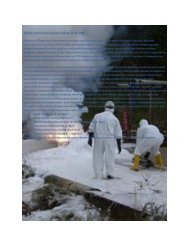SESHA 2011 Program Book - Semiconductor Safety Association
SESHA 2011 Program Book - Semiconductor Safety Association
SESHA 2011 Program Book - Semiconductor Safety Association
Create successful ePaper yourself
Turn your PDF publications into a flip-book with our unique Google optimized e-Paper software.
stakeholder events and solicits input from stakeholders<br />
for continuous improvement of the Code of Conduct.<br />
The Code of Conduct provides guidance in five critical<br />
areas of CSR performance: • Labor • Health and <strong>Safety</strong><br />
• Environment • Management System • Ethics<br />
11:30 am Lunch on your Own<br />
1:00-3:15 pm<br />
GHG<br />
Sonora C<br />
1:00 pm PCS PIRANHA Plasma Abatement System:<br />
Update of Evaluation on 300mm Etch Process<br />
Kopatzki, E, Guerin, J; CS Clean Systems<br />
Introduction by the EPA in mid 2010 of Reporting<br />
rules on greenhouse gases has led to a heightened level<br />
of interest in PFC reduction within the semiconductor<br />
and related industries. In view of the limited number of<br />
practical options available to the typical semiconductor<br />
manufacturing facility for the curtailment of CO2 equivalent<br />
emissions, PFC abatement offers a convenient<br />
route to more environmentally-friendly manufacturing<br />
as well as compliance with present and future EPA policies.<br />
The PCS PIRANHA plasma conversion system<br />
uses a 2kW or 3kW microwave plasma to decompose<br />
PFC gases into reactive fluorine/ fluoride species which<br />
are readily removed by a downstream scrubber. The unit<br />
is fitted inline within the vacuum foreline between the<br />
etch chamber exhaust and dry roughing pump. A 2.45<br />
GHz microwave is generated by a magnetron and conducted<br />
into the exhaust gas stream. This setup ensures<br />
that the full microwave power is focussed on the PFC<br />
gases prior to dilution by the N2 ballast of the dry pump,<br />
allowing very high PFC destruction efficiencies to be<br />
achieved. This presentation will discuss the results of<br />
current testing carried out using a 3kW pre-pump microwave<br />
plasma device. The evaluation is being carried out<br />
in conjunction with a vendor of Etch tools using stateof-the<br />
art 300 mm recipes over a wide range of PFC gas<br />
flows and foreline pressure regimes.<br />
1:45 pm Guideline for GHG Emission Measurement<br />
and Management<br />
Kagino, M; Toshiba, Tokyo Japan<br />
JEITA thinks that we need grasp of the amount of<br />
emission of F-GHG in order to advance a battle against<br />
global warming, and the technique of the suitable and efficient<br />
amount grasp of F-GHG emission contributes to<br />
progress of the battle. The IPCC 2006 guideline requests<br />
that the performance is measured and checked under a<br />
use situation as the conditions which can use a default<br />
value at the abatement efficiency of F-GHG abatement<br />
equipment. JEITA had already exhibited the guideline<br />
for measurement. Since JEITA revised this extensively<br />
this time, I will introduce this. This guideline provides<br />
the efficient measuring method and the management<br />
method such as time and frequency of the efficient measurement<br />
to users of the equipment which use F-GHG.<br />
And it will assist users to grasp exactly the amount of<br />
emission of F-GHG which oneself has discharged, and<br />
to make plan for reduction based on these results, and to<br />
carry out.<br />
2:30 pm Global Warming Evaluation of Chamber<br />
Cleaning Gases by New Indicators, CEWN and<br />
CETN<br />
Sekiya, A, Okamoto, S; National Institute of Advanced<br />
Industrial Science and Technology (AIST), Japan<br />
Dealing with the global warming is still big issue<br />
because the Earth temperature has been rising. <strong>Semiconductor</strong><br />
and liquid crystal industries have been used longlived<br />
fully fluorinated compounds that have high global<br />
warming effects. The long-term evaluation of global<br />
warming caused by the use of these gases has to be paid<br />
much more attentions. On the other hand, evaluation<br />
metric is quite important to get scientifically reliable<br />
results. In this paper, using LCCP (Life Cycle Climate<br />
Performance) data of our previous work, CVD chamber<br />
cleaning gases are evaluated by new global warming indicators,<br />
CEWN1) (Carbon Dioxide Equivalent Warming<br />
Number), CETN2) -(Carbon Dioxide Equivalent<br />
Temperature Change Number), and s-CETN2) (square-<br />
Carbon Dioxide Equivalent Temperature Change Number<br />
). CEWN evaluates based on radiative forcing as<br />
GWP3). CETN and s-CETN are based on the global<br />
surface temperature rise by Shine’s equation4). CEWN<br />
and CETN compare GHGs by unifying the removal rate<br />
of each gas from the atmosphere, while s-CETN unifies<br />
the ratio to the total amount of the global warming of<br />
each gas. They provide fair index of global warming to<br />
each GHG. LCCP data is analyzed using GWP, CEWN,<br />
CETN, and s-CETN and compared. Results show that<br />
CEWN, CETN, and s-CETN are as easy-to-use as GWP.<br />
Further, the relation of CEWN, CETN, s-CETN values<br />
with the climate impact is clearer than that of GWP<br />
values. According to those new indicators, the order of<br />
global warming is C2F6 > C3F8 > NF3>> COF2. In<br />
the case where 16% 5) of NF3 production releases into<br />
23




